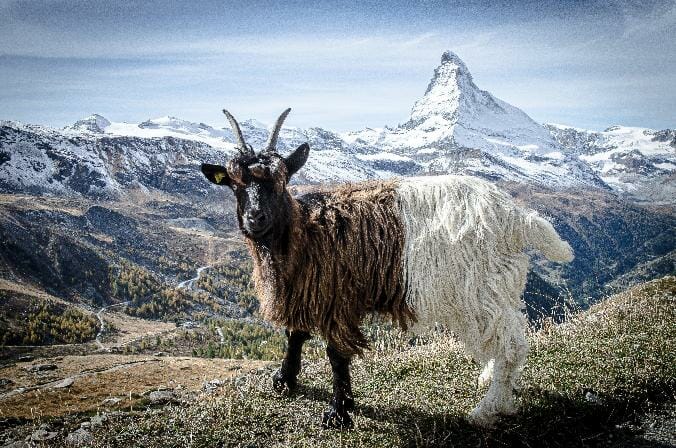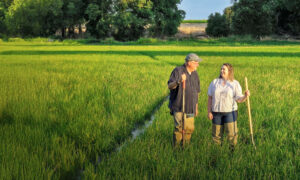When most people think of Switzerland, they may see images of dramatic mountains piercing the sky, lush green valleys, cerulean lakes, and quaint villages. Some may also conjure images of the region’s symbolic Brown Swiss cattle sporting bells around their necks. The hearty dairy breed holds the record of the second largest milk producing bovine. That’s no small feat considering that these beauties deal with some serious terrain in the Alpine pastures of Switzerland.
It’s no wonder, then, that Switzlernad is 100% self-sufficient in milk. It’s also proficient in producing fruits, vegetables, wine, and cereals. Considering that the vast majority of farms in Switzerland are smallholdings around 52 acres, that’s a pretty impressive effort.
“I grew up on one of the first organic farms in Switzerland in the Emmental region,” Daniel Baertschi tells AFN. “My father converted our dairy farm to organic because Emmental cheese that we exported to the US was refused by the health authorities when they found pesticide residues. He was thinking about all this pesticide and what the impact might be and that was the beginning of my story.”
Baertschi recalls the scrutiny that his father received from other farmers after making the switch to organic. Sometimes, being the first one to pioneer a new trend can be ostracizing as colleagues fail to see the point in doing old things in new ways. It would appear that Baertschi’s father has the last laugh now as Swiss farmers are converting to organic at a steady rate. Between 2000 and 2017, the number of organic farming operations in the country doubled from 7.7% to 14.5% despite a decline in the total number of farms.
He then studied agronomy before joining a swiss organic umbrella organization called BioSuisse that maintains a farmer-owned consumer brand. But eventually, Baertschi began to wonder whether organic is enough. The growing dominance of mainstream players in the organic market was one of the factors that raised this question in his mind. As organic goes mainstream and becomes more conventional, it can leave small organic producers in the dust. Blend in an interest in promoting biodiversity in agriculture and he soon found himself standing at regenerative farming’s doorstep.
“It’s a term that was not well-known here two-to-three years ago, but we’ve been inspired by the US and Australian movements that are gaining momentum,” he said.
Now, Baertschi is heading up a new Swiss organization called Agricultura Regeneratio comprised of farmers, processors, traders, consumers, and the entire value chain. The group’s first goal is to provide training and educational opportunities by bringing in heavyweight speakers such as Joel Salatin, a thought leader in regenerative farming, to train farmers and raise awareness around the movement.
“We also want to work with politicians and parliament to have some additional funding to increase knowledge. It’s really an information campaign,” he explains. “On the farm side, it’s really about training through webinars and finding funding or organizations who are willing to step in. It’s also about funding ideas. We have a lot of foundations in Switzerland that are supporting different initiatives and hope to tap into that.”
It’s not the cow, it’s the how
For a country with an agriculture industry primarily based on livestock production, regenerative agriculture has offered Baertschi and other livestock farmers in the region a platform for speaking with consumers amid a rising tide of anti-meat rhetoric. One of the five pillars of regenerative agriculture is integrating well-managed ruminant animals like cattle, sheep, and goats to provide manure, build soil health, manage plant growth, and to upcycle crop residues.
An analysis of Google Trends earlier this year revealed that Switzerland ranked eighth in Europe for internet searches for things like “vegan restaurants near me” or “vegan recipes,” according to Chef’s Pencil. The UK ranked highest followed by Sweden, Ireland, Austria, Germany, Finland, and Denmark.
“Most of the consumers think we have to just stop eating meat and that will save our planet but that is not the way we want to follow. We want to tell people to look for good meat: grass-fed, pasture-raised and locally produced. We want to raise an image of meat in terms of its ability to produce climate-negative meat,” he says. “What we have now is an integrated system in meat production dominated by supermarkets and processors. Consumers are reluctant to get away from that and to buy directly from farmers but we see the meat industry as important. We shouldn’t replace it with plant-based production because that usually means highly-processed and, to me, the best is unprocessed as much as possible.”
Discussions around regenerative agriculture often eventually meander into the realm of agtech and whether any innovations could help foster this new movement or perhaps prove its value proposition to investors’ satisfaction. But Switzerland’s average farm size highlights an important question that I’ve been exploring recently: do entrepreneurs and investors only see value in innovating for large-scale farms? According to Baertschi, the small statute of his country’s farms has stymied agtech adoption in the country.
“Most tech is focused on commodity production. Small farming is about a cost and benefit calculation. If you have 25 cows, you don’t need sensors to find out who is healthy and who is not. But if you have 500 cows, that’s more important,” he explains. “Second, we don’t have a clear strategy at the national level in terms of where we want to go in the digitization of agriculture. We lack an organization that is bringing together different players in the field and creating something useful for farmers. Many of the tools are nice, but they aren’t keeping the farmer in mind.




